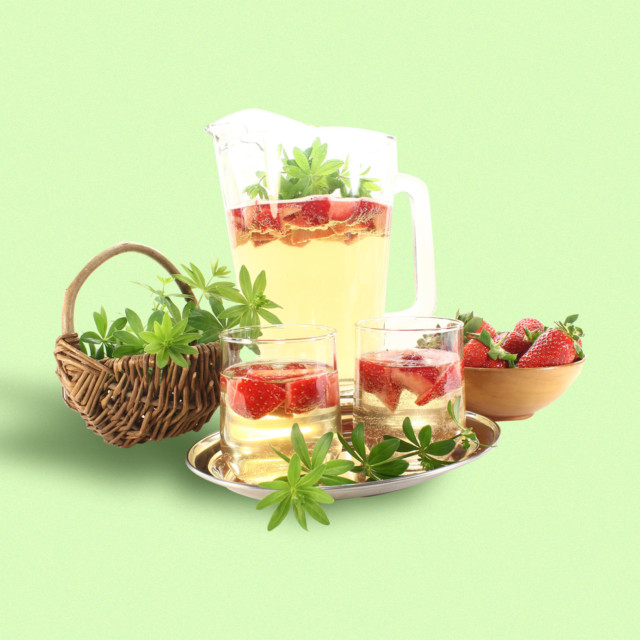The calendar year is awash with holidays that command we drink. On New Year’s Eve, we are instructed to pop some Champagne. On March 17, we go forth in search of Irish whiskey, Irish Coffees, and green beer. On May 5, tequila must be consumed.
One drinking holiday that has been lost over the years, however, is the May Wine Festival and its accompanying beverage, the May Bowl. Or, if you’re German, Maifest and Maibowle.
Maifest is a German festival that celebrates the arrival of spring. The holiday goes back centuries. Traditionally, towns are decked out in flowers, a maypole is erected, and bonfires are lit. And what would any festival be without intoxicating drinks? To fill this need, there is Maibock, a German beer brewed only during spring, and the Maibowle, a punch made of German wine, Champagne, sugar, strawberries, sometimes brandy and, critically, woodruff.
Woodruff, also known as waldmeister, is an herb that is among the first to sprout following German winters. It grows in the forest and flowers in late April. As such, it is traditionally viewed as a harbinger of spring in that country. For the Maibowle, the wine is steeped with fresh woodruff for a few hours, or sometimes overnight, giving the punch an herbal aroma not unlike fresh grass or clover.
The disappearance of Maifests and Maibowles in the United States is most likely due to the general decline in German culinary culture. As recently as 50 years ago, German restaurants were common sights in many cities. But over time, their heavy, meat-and-potatoes-focused cuisine has fallen out of favor with Americans. In New York, for example, only a handful of German restaurants remain and none of them hold a Maifest come the first of the month. Killmeyer’s is a German restaurant on Staten Island that traces its roots back to the 19th century. When I asked whether they served a Maibowle, a spokesperson told me, “We are primarily a beer hall. Our clientele tends to be unfamiliar with the various German wines, so we learned long ago not to expend the effort in this area.” (In Germany, Maibowle is still popular enough that you can buy a commercial version of the punch in bottled form. And the candy company Ritter Sport puts out a Maibowle-flavored chocolate bar.)
The restaurant that did the most to keep the Maibowle tradition alive in New York was the city’s most famous German dining institution: Lüchow’s. From 1882 to 1982, Lüchow’s stood at 110 East 14th Street. Only a stone’s throw from the Academy of Music, Steinway Hall, and Tammany Hall, Lüchow’s was not only a hub of German culture in the city, but all culture, attracting a clientele composed of the biggest names in music, theater, and politics.
The May Wine Festival was one of five festivals around which the Lüchow’s calendar revolved, the others being the Venison Festival, the Goose Festival, the Bock Beer Festival, and the ancient German Midsummer Festival. (To read this list of events is to suspect that New York restaurants of today do not know how to have a good time.) According to a 1956 article in The Daily News, the May Wine Festival was “for many New Yorkers, a more dependable sign of spring than the weather itself.”
A passage in the Lüchow’s Cookbook (1952) offers some details on what a typical Maifest was like:
In 1951, again for the first time since 1935, we held the May Wine Festival, amid vine leaves and grapes draped about the restaurant, in tribute to Bacchus, while the German band played the spring music that attends the festival. On the menu there is that seasonal dessert, cabinet pudding with May wine sauce. We take down our May wine bowls, hitherto filled only with history, and fill them with the springlike potion which has been celebrated for centuries along the banks of the Rhine, and continues to be a great delight here at Lüchow’s, thousands of miles from its origins.
Since there is no place left in New York where I might enjoy a cup of Maibowle, I decided to whip up a batch of the punch myself. Luckily, Lüchow’s recipe was printed in its cookbook. However, making the brew was a bit of a challenge, because woodruff does not grow on trees. None of the herb stores I called carried it. I finally found woodruff where one finds most anything in the way of rare and unusual herbs and spices in New York — Kalustyan’s, the foodie institution at the corner of 28th Street and Lexington Avenue. But even Kalustyan’s didn’t have fresh woodruff. It only had the herb in dried form.
For the wine, I used a dry Riesling. I substituted six teaspoons of dried woodruff for the prescribed six “bunches” of the herb. I then let it steep overnight before straining. The Champagne is added last; I have read that this final step in completing the punch was traditionally performed in front of one’s guests.
So, does a Maibowle taste of springtime? Well, as far as I’m concerned, there’s no losing with a punch that is already composed of Riesling, Champagne, and brandy. But, yes, there was a distinct verdant freshness to the punch. It did taste like spring. Now, to find that recipe for cabinet pudding!
Lüchow’s Maibowle
Ingredients
- 6 bunches waldmeister, or woodruff
- ½ pound powdered sugar
- 1 cup Cognac
- 4 quarts Moselle or Rhine wine
- Ice
- 2 quarts Champagne or charged water
- 1 cup fresh strawberries
Directions
- Wash herbs. Place in large bowl with sugar, Cognac, 1 quart Moselle or Rhine wine. Cover bowl; let stand overnight.
- To serve, strain mixture, pour over ice in a large punch bowl, and add remaining three quarts Moselle or Rhine wine. Add Champagne or charged water. Float strawberries in the bowl. Serves 10 to 15.
